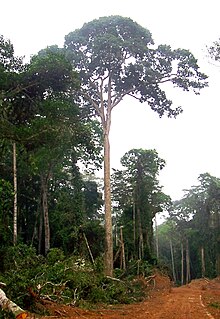Entandrophragma

| Entandrophragma | |
|---|---|
 | |
| Entandrophragma cylindricum | |
| Scientific classification | |
| Kingdom: | Plantae |
| Clade: | Tracheophytes |
| Clade: | Angiosperms |
| Clade: | Eudicots |
| Clade: | Rosids |
| Order: | Sapindales |
| Family: | Meliaceae |
| Subfamily: | Cedreloideae |
| Genus: | Entandrophragma C. DC. |
| Species | |
| See text | |
| Synonyms[1] | |

Entandrophragma is a genus of eleven known species of deciduous trees in the family Meliaceae.
Description
[edit]Entandrophragma is restricted to tropical Africa.[2][3] At least some of the species attain large sizes, reaching 40–50 m tall, exceptionally 60 m, and 2 m in trunk diameter. In 2016 a specimen of Entandrophragma excelsum towering at a height of 81.5 m (267 ft 5 in) tall, and a 2.55 m (8 ft 4 in) dbh[4] was identified at Kilimanjaro.[5]
It is dioecious, with male and female flowers on separate plants.[6] The leaves are pinnate, with 5-9 pairs of leaflets, each leaflet 8–10 cm long with an acuminate tip. The flowers are produced in loose inflorescences, each flower small, with five yellowish petals about 2 mm long, and ten stamens. The fruit is a five-valved capsule containing numerous winged seeds.
Species
[edit]Accepted 11 Species:[1]
- Entandrophragma angolense (Welw.) Panshin
- Entandrophragma bussei Harms ex Engl.
- Entandrophragma candollei Harms
- Entandrophragma caudatum (Sprague) Sprague
- Entandrophragma congoense (Pierre ex De Wild.) A.Chev.
- Entandrophragma cylindricum (Sprague) Sprague
- Entandrophragma delevoyi De Wild.
- Entandrophragma excelsum (Dawe & Sprague) Sprague
- Entandrophragma palustre Staner
- Entandrophragma spicatum (C.DC.) Sprague
- Entandrophragma utile (Dawe & Sprague) Sprague
Uses
[edit]The timber of a few species is traded as a tropical hardwood. It is sometimes termed under the generic label of mahogany, and while Entandrophragma is part of the family Meliaceae, it is not classified as genuine mahogany. The species shares many of the characteristics of genuine mahogany and is used as an alternative, with Sapele and Utile in particular bearing a close resemblance.[7][8]
References
[edit]- ^ a b science.kew.org / Entandrophragma C.DC. | Plants of the World Online
- ^ Klaus Kubitzki (10 December 2010). Flowering Plants. Eudicots: Sapindales, Cucurbitales, Myrtaceae. Springer Science & Business Media. pp. 194–. ISBN 978-3-642-14397-7.
- ^ Entandrophragma C. DC. in Bull. Herb. Boissier 2:582 t.21 (1894)
- ^ researchgate.net / Africa’s highest mountain harbours Africa’s tallest trees; Authors: Hemp Andreas, Reiner Zimmermann, Sabine Remmele, Ulf Pommer, Bernd Berauer, Claudia Hemp, Markus Fischer | January 2017 | Biodiversity and Conservation 26(1):1-11 | DOI:10.1007/s10531-016-1226-3
- ^ "Africa's tallest tree measuring 81m found on Mount Kilimanjaro".
- ^ James W. Byng (Oct 16, 2014). The Flowering Plants Handbook: A practical guide to families and genera of the world. Plant Gateway Ltd. ISBN 978-0992999315.
- ^ Utile Archived 2012-03-16 at the Wayback Machine. Niche Timbers. Accessed 20-09-2009.
- ^ Mahogany Mixups: the Lowdown - The Wood Database
External links
[edit]- Tiama Entandrophragma angolense
- Kosipo Entandrophragma candollei
- Sapeli Entandrophragma cylindricum
- Sipo (Utile) Entandrophragma utile